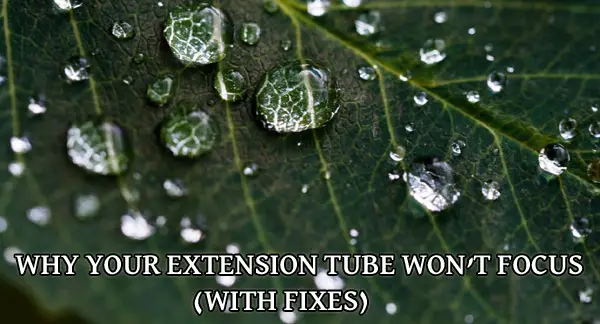Photography 102 - Why Your Extension Tube Won’t Focus (With Fixes)
You want to take a lovely photo of the delicate swirls of a seashell. The only problem is…you can’t figure out why your extension tube won’t focus. Macro photography takes you into the beautiful and enticing world of the minuscule. A dewdrop hanging from the end of a calla lily, an insect drinking nectar from a flower, the brilliant sparkle of the diamonds in a wedding ring — these photos are made possible by macro lenses.




But macro lenses are expensive so you may have opted to use an extension tube with a regular lens instead.
How does an extension tube mimic the look of a macro lens? This tube moves the lens farther away from the camera’s sensor, allowing you to get closer to your subject and increase the magnification.
However, if you’ve ever used an extension tube, you may have had trouble focusing it. Read on to find out why your extension tube won’t focus and, more importantly, how to fix it. An extension tube not focusing may have to do with the distance to your subject, choosing a different focal length, or buying extension tubes with the electric component.
What Are Extension Tubes?
An extension tube is an apparatus that you attach to your camera and then attach your lens to. It looks like a regular camera lens, but it’s missing one key component — the glass.

It’s literally a hollow tube whose purpose is simply to increase the distance between your lens and the camera sensor. The farther the distance, the closer the lens can be to the subject and the more magnified the subject will be.
Calculating the Distance
How much magnification can you get with extension tubes? It varies depending on how long your extension tubes are and the focal length of the lens you’re using.
The math to figure out the magnification factor is pretty simple. Simply divide the length of the extension tube in millimeters by the focal length of the lens.
For example, say you combine a 25mm extension tube with a 50mm lens. 25 divided by 50 gives you a magnification factor of x0.5. This can also be written as a ratio 1:2, meaning that the object is projected at half it’s life-size onto the camera’s sensor.
To achieve a 1:1 ratio, or to take an image of the object at life-size, combine a 50mm extension tube with a 50mm lens. If you want to use a longer focal length and still get a 1:1 ratio, simply use a longer extension tube. Try 85mm of distance with an 85mm lens, 100mm of distance with a 100mm lens — you get the picture.
You can also literally magnify your subject by using a higher ratio. For example, use 100mm of extension with a 50mm lens. Then you can focus on bringing even tinier details to life.

Which Focal Lengths Work Best?
You can use extension tubes with virtually any focal length from wide angle to telephoto. Although, short to mid-range focal lengths tend to give the best results. Which focal length you should use depends on the type of photo you want to take.
Shorter focal lengths will give you more magnification. Longer focal lengths will give you more working distance, but the effect will be less macro-like.
Many people like to start with a basic 50mm lens. As a small, light lens, it’s easy to play around with. Plus, it’s easy to obtain a 1:1 magnification ratio without adding too much weight to the camera.
It’s important to consider the weight. Heavier cameras are harder to hold perfectly still and camera shake will already be increased because of the magnification.
Try experimenting with the lenses you own to get an idea of how photos will turn out at different focal lengths. Don’t forget to change up the distance on the extension tubes if you bought a set that allows you to do that.
Remember that changing the length of the extension tube also changes the working distance. You may need to move closer to your subject for it to be in focus.
Comments
Post a Comment